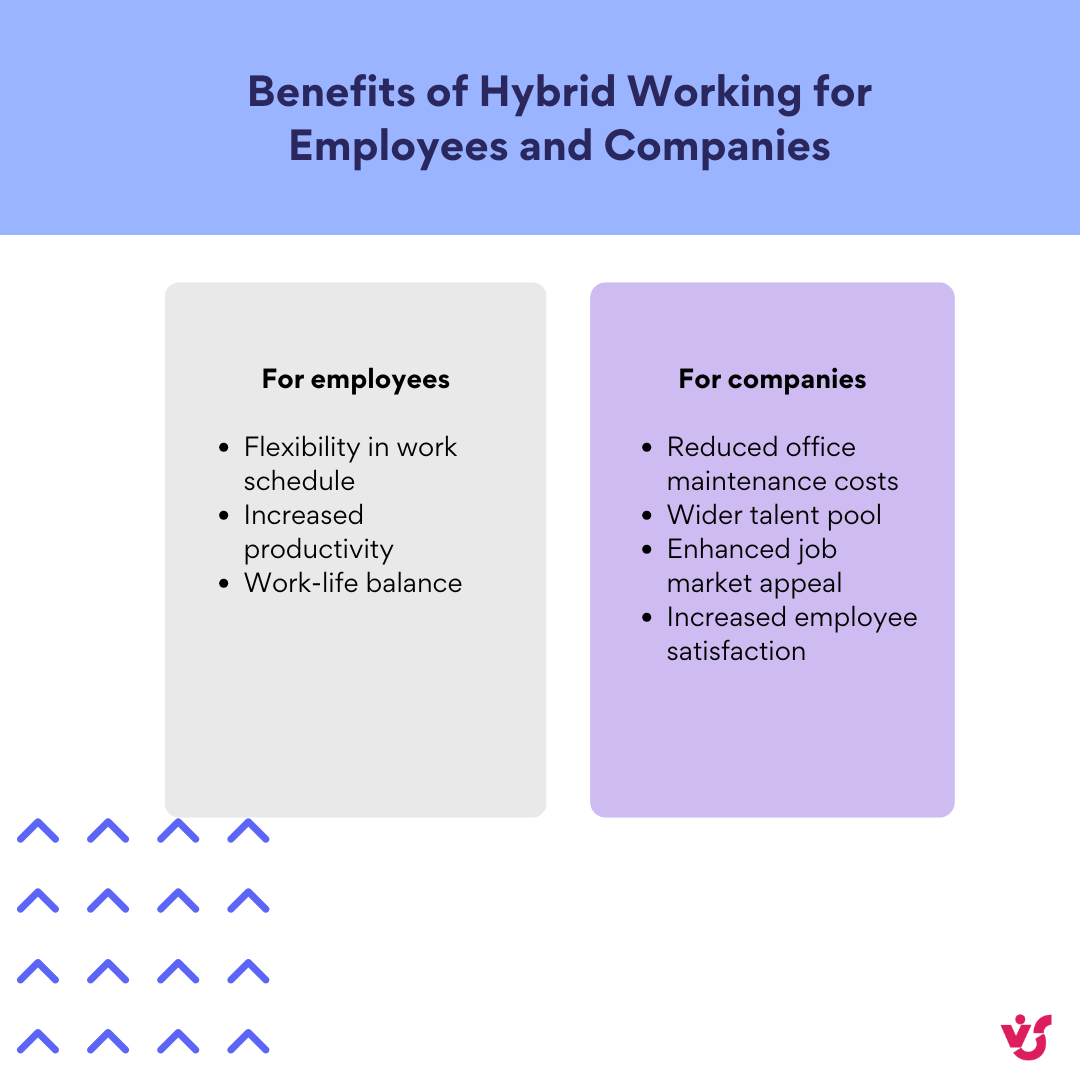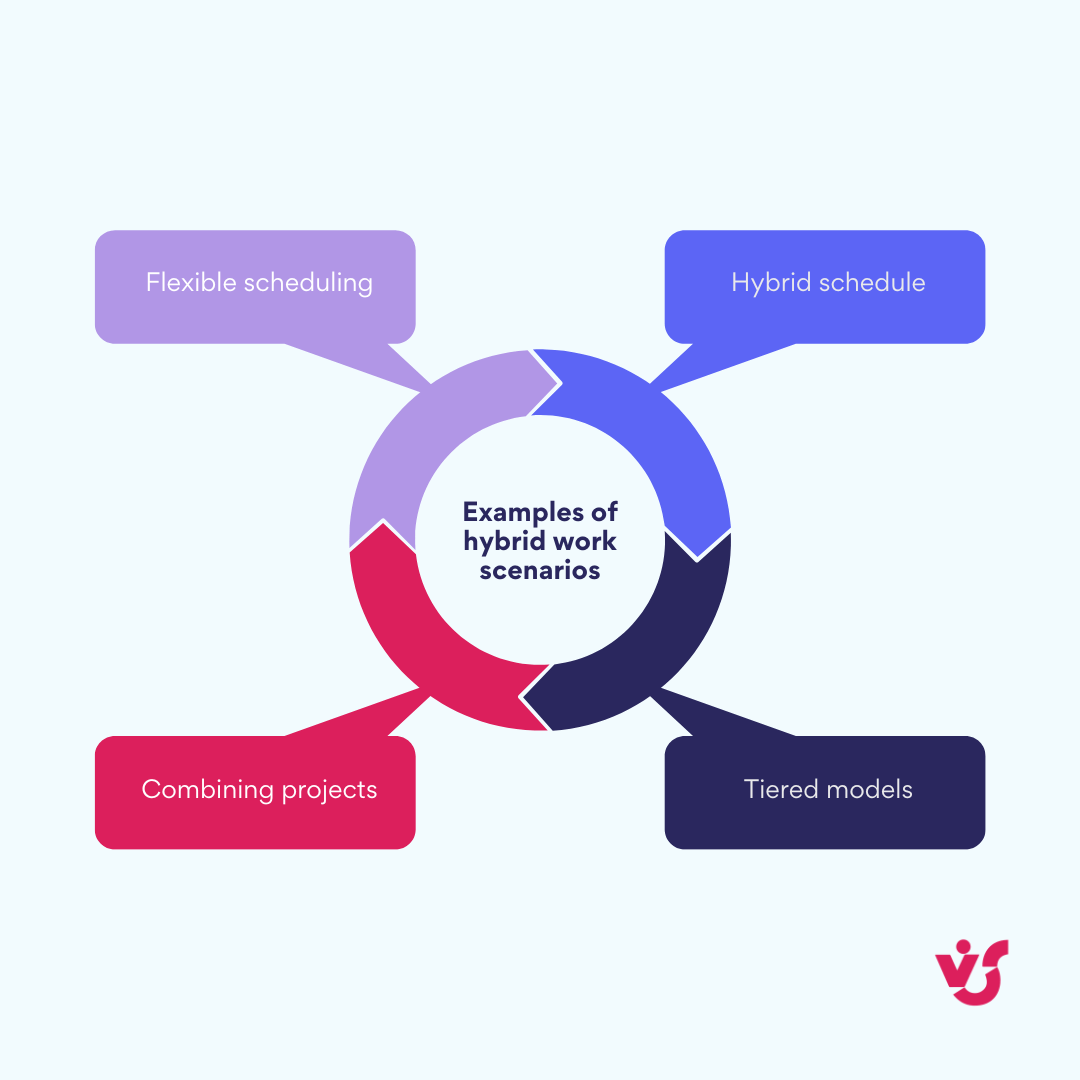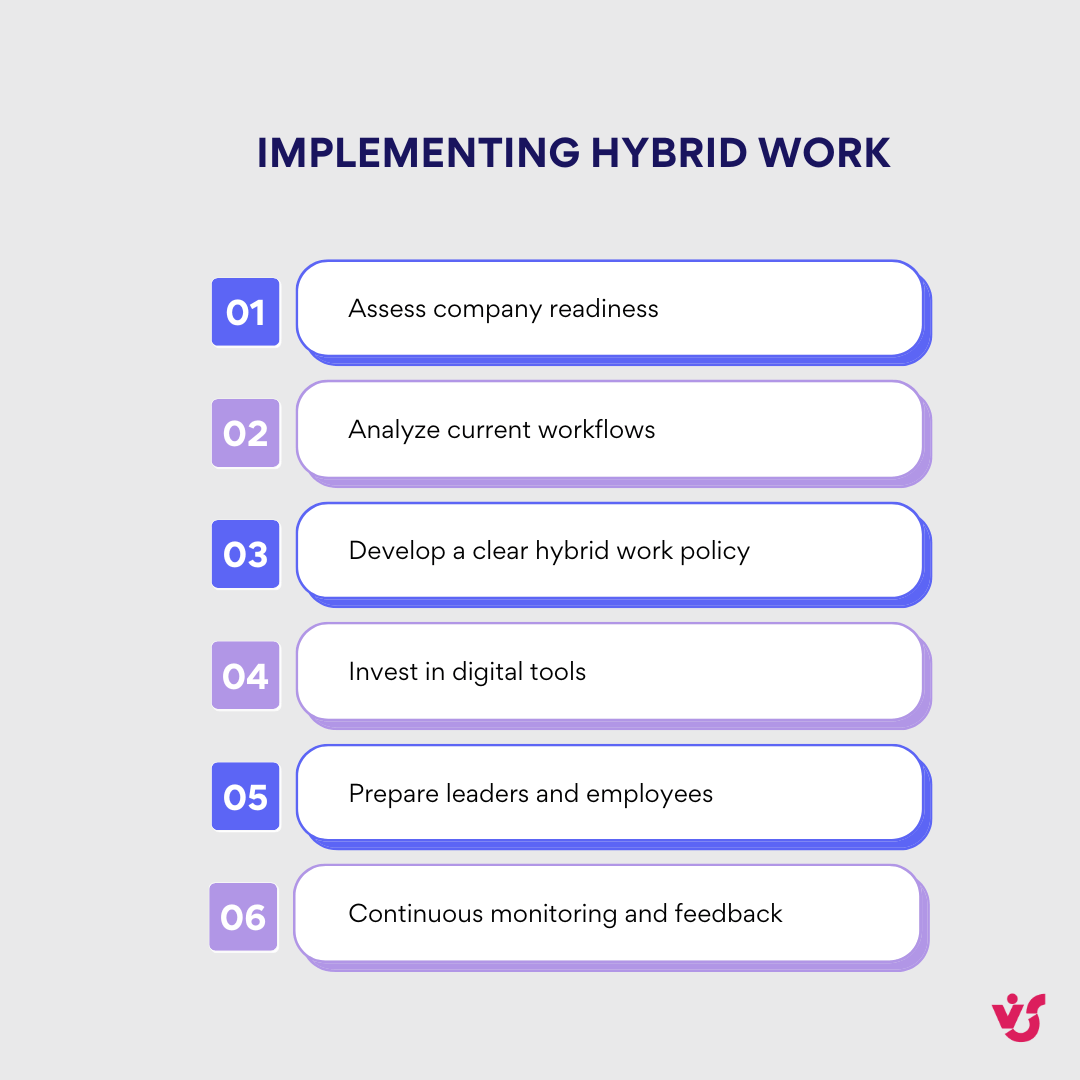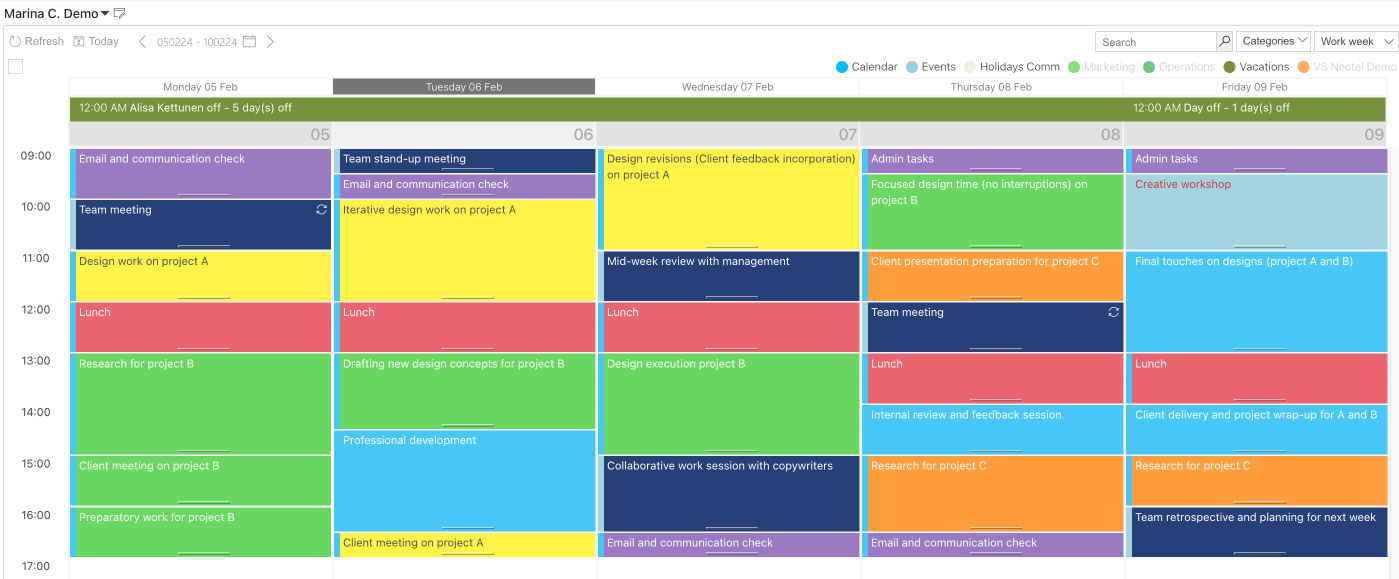Imagine a workplace where flexibility meets productivity, and creativity knows no bounds. Welcome to the world of hybrid work environment, where the lines between home and office are blissfully blurred. This innovative model has become the go-to strategy for forward-thinking businesses looking to boost efficiency, attract top talent, and keep employees happy.
The COVID-19 pandemic may have been the catalyst that accelerated the shift towards the hybrid work model, but its benefits extend far beyond mere necessity. By combining the best of remote and in-office work, companies can create a dynamic ecosystem that fosters collaboration, innovation, and a healthier work-life balance.
In this setup, employees can choose when to focus on solo tasks from the comfort of their homes and when to join forces with colleagues in the office. It’s a win-win situation that not only boosts job satisfaction but also drives business success.
What is hybrid work? In this article, we’ll delve into the ins and outs of hybrid working. We’ll define what it means, explore its advantages and potential challenges, share expert tips for seamless implementation, and highlight how automation tools can be your trusted allies in making this transition smooth and successful.
👉🏻 Before finding out what hybrid working is, check out our previous articles on how to make the most of remote work environments:
- How to Enhance Teamwork with Remote Work Collaboration
- 14 Remote Collaboration Tools
- Cross-Team Collaboration
What is a Hybrid Work Environment?
A hybrid work environment is a model that seamlessly blends traditional office work with remote work, allowing employees to split their time between these two settings. This flexible approach has become a game-changer for many companies, boosting productivity and improving the quality of life for their employees.
The hybrid work setting has gained significant traction globally, with many countries embracing its benefits. For instance, in the Asia-Pacific region, 85% of companies actively promote hybrid work, recognizing its potential to transform the way people work (source). In Europe, the hybrid workforce model remains a dominant arrangement, with 44% of EU employees in roles that can be performed remotely opting for this model (source). Globally, 43.54% of surveyed consumers across 11 countries prefer hybrid work from home, underscoring its widespread appeal (source).
Research consistently shows that hybrid environments have a positive impact on productivity, employee satisfaction, and overall well-being. Studies indicate that employees who work in hybrid settings often report higher job satisfaction and better work-life balance compared to those in purely office-based or remote environments. Moreover, hybrid work strategy allows companies to reduce operational costs and boost collaboration, as employees can choose when to focus individually and when to engage in team activities.
Looking ahead, the popularity of hybrid work models is expected to continue growing. Advances in technology will play a crucial role in making hybrid work more seamless and efficient. Innovations in communication tools, cloud services, and cybersecurity will enable smoother transitions between different work settings. As companies adapt to these changes, they will likely focus on creating robust digital infrastructures and fostering strong communication cultures to support their hybrid workforces.
In the near future, businesses will need to be agile and responsive to the evolving needs of their employees and the market. This might involve implementing flexible schedules, investing in digital tools, and ensuring that all employees have equal access to resources, regardless of their work location. By embracing these changes, companies can position themselves for success in a world where flexibility and adaptability are key.
👉🏻What is a hybrid work environment? A hybrid work environment combines remote and in-office work, offering flexibility while maintaining collaboration. Employees may follow a set schedule or choose where they work. This approach offers flexibility while maintaining collaboration and productivity. Companies design hybrid models based on their needs, such as:
- Fixed hybrid: Employees have set days for remote and in-office work.
- Flexible hybrid: Employees choose when and where they work.
- Remote-first: Most employees work remotely, but office space is available when needed.
Hybrid Work Environments: Benefits of Hybrid Working for Employees and Companies
The traditional 9-to-5 office routine is no longer the only way to get work done. Hybrid workplace solutions offer a blend of flexibility, productivity, and satisfaction for both employees and companies. Let’s dive into the key advantages that make hybrid work a win-win for everyone involved.
Benefits for employees
- Flexibility in work schedule: imagine being able to manage your day as you see fit. With hybrid work, employees can choose when and where they work best, whether that’s from home, in the office, or a combination of both. This flexibility allows for a better alignment of work and personal responsibilities.
- Increased productivity: when employees feel comfortable and supported in their work environment, they tend to be more productive. Hybrid work allows individuals to create their ideal workspace, whether that means a quiet home office or a bustling co-working space. This comfort translates into higher efficiency and better results.
- Work-life balance: achieving a balance between work and personal life is crucial for well-being. Hybrid work environments make it easier for employees to attend to family needs, pursue hobbies, or simply enjoy some extra time in the morning without the commute. This balance leads to happier, healthier employees.
Benefits for companies
- Reduced office maintenance costs: by not needing to maintain a full-capacity office space, companies can significantly cut down on overhead costs such as rent, utilities, and equipment. These savings can be reinvested in other areas of the business.
- Wider talent pool: hybrid workspace solutions open up the possibility of hiring the best talent from anywhere, not just locally. This means companies can access a broader range of skills and experiences, leading to more diverse and innovative teams.
- Increased attractiveness in the job market: in today’s competitive job market, offering flexible work arrangements can be a major draw for top candidates. Companies that embrace hybrid work models are seen as forward-thinking and employee-centric, making them more attractive to potential hires.
- Higher employee engagement and satisfaction: when employees feel valued and supported, they are more likely to be engaged and satisfied with their work. Hybrid working environments foster a sense of trust and respect, leading to a more motivated and committed workforce.

Hybrid Work Models, Implementation Approaches, and Examples
As we delve into the world of hybrid work models, it’s essential to understand that these models are not one-size-fits-all solutions. Different organizations require different approaches based on their unique needs, cultures, and operational requirements. Let’s explore some of the most common hybrid work models, their implementation strategies, and real-life examples that illustrate their effectiveness.
Hybrid work models
Hybrid work environments come in various forms, each tailored to meet the unique needs of different organizations. Here are some of the most common models:
| Hybrid Work Model | Description | Example |
| Fixed Schedule | Employees work in the office on specific days and remotely on others. | Mondays, Wednesdays, and Fridays in the office; Tuesdays and Thursdays remote. |
| Flexible Schedule | Employees choose which days to work remotely or in the office. | Employees decide daily based on task requirements and personal preferences. |
| Role-Based Model | Hybrid work applies only to roles requiring less face-to-face interaction. | Customer service roles might work remotely, while sales teams work in the office. |
| Distributed Team Model | Part of the team works in the office, while another part works entirely remotely. | Marketing team in the office, IT team fully remote. |
These hybrid workspace systems can be adapted based on an organization’s size, industry, corporate culture, and regional specifics. For instance, a tech startup might prefer a flexible schedule to foster innovation, while a financial institution might opt for a role-based model to ensure compliance with regulatory requirements.
Implementing these models successfully requires a clear policy framework, training for managers, and support for employees during the transition. Clear communication and feedback loops are essential to ensure that everyone understands their roles and responsibilities in the new hybrid setup.
Examples of hybrid work scenarios
Hybrid work scenarios can vary widely depending on the company’s needs and goals. Here are some typical examples:
Alternating office and remote days
Employees might work in the office three days a week and from home two days. This setup allows for regular team interactions while also providing flexibility.
Flexible time management
Employees can choose when to come into the office or work from home based on the tasks they need to complete. For example, collaborative projects might be done in the office, while writing tasks can be completed at home.
Combining projects
Some projects require in-person collaboration, while others can be efficiently managed remotely. Hybrid models allow companies to balance these needs effectively.
Tiered models
Different teams within the same company might adopt different work arrangements. For instance, one team might work entirely remotely, another on a hybrid schedule, and a third team might remain in the office full-time.

Examples from real-life practice: successful implementation of hybrid work models
eBay: eBay has implemented a flexible hybrid model where employees can choose to work remotely or come into the office based on team needs. This approach allows for both collaboration and personal flexibility. Source.
JPMorgan: JPMorgan requires managing directors to work full-time in the office, while other staff members work three days a week in the office. This model is designed to balance remote work flexibility with the need for in-person collaboration. Source.
Zoom: Despite being a pioneer in remote work tools, Zoom has adopted a structured hybrid approach. Employees living within 50 miles of an office must report to the office at least twice a week, ensuring a balance between remote and in-person work. Source.
👉🏻What is an example of hybrid work? An example of hybrid work is a company where employees work from home three days a week and come to the office on two days for meetings and collaboration. Another example is a remote-first company that provides office space for employees who prefer to work on-site occasionally.
Challenges and Risks of Hybrid Work Environments
As appealing as hybrid work models are, they come with their own set of challenges and risks. Let’s explore some of the key difficulties that organizations might face:
- Lack of clear policy: without a well-defined policy on hybrid work, confusion can arise about expectations for working from home versus the office. This ambiguity can lead to misunderstandings and inefficiencies.
- Maintaining corporate culture: hybrid work environments can make it harder to maintain a strong corporate culture. When employees are not consistently in the office, it’s challenging to foster a sense of community and shared values.
- Collaboration and communication challenges: organizing effective collaboration and communication becomes more complex when team members are not always in the same location. This can lead to missed deadlines and misunderstandings.
- Reduced personal interaction: less face-to-face interaction can complicate teamwork, as nonverbal cues and spontaneous conversations are lost. This can hinder creativity and problem-solving.
- Scheduling conflicts: with different schedules, there’s a risk of inconsistent availability among team members, which can disrupt workflow and collaboration.
- Data security risks: remote work increases the risk of data breaches if proper security measures are not in place. Ensuring that all remote workers have secure connections and follow best practices is crucial.
Impact on team effectiveness
Problems with communication and task management can significantly impact team effectiveness. When team members are not well-coordinated, projects can stall, and goals may not be met. Effective communication is key to keeping everyone on the same page and ensuring that tasks are completed efficiently.
Psychological сhallenges
Transitioning to a hybrid work model can also present psychological challenges for employees. Feelings of isolation can arise when working remotely, making it harder to disconnect from work and maintain a healthy work-life balance. Employees might struggle to establish clear boundaries between their professional and personal lives, leading to burnout or decreased motivation.
Minimizing drawbacks
To mitigate these challenges, organizations can take several things into consideration:
- Advanced digital tools: implementing sophisticated project management and communication tools can help streamline workflows and keep everyone connected. Platforms like Slack, Trello, and Zoom are invaluable for hybrid teams.
- Regular office meetings: holding regular in-office meetings can help maintain team spirit and ensure that everyone feels connected. These meetings provide opportunities for face-to-face interactions that are essential for building trust and camaraderie.
- Clear communication channels: establishing clear channels for communication is vital. Regular check-ins, both virtually and in-person, can help prevent misunderstandings and keep projects on track.
- Employee support programs: offering support programs for employees can help address psychological challenges. This might include mental health resources, flexible work arrangements, and team-building activities to combat isolation.
- Training for managers: providing training for managers on how to effectively manage hybrid teams is crucial. This includes skills in remote communication, task delegation, and conflict resolution.

Importance of a clear management strategy
To minimize the risks associated with hybrid work environments, it’s essential to have a clear management strategy in place. Managing a hybrid workforce involves setting clear expectations, implementing strong developed communication systems, and ensuring that all employees feel supported and connected. By addressing these challenges proactively, organizations can reap the benefits of hybrid work while maintaining a productive and engaged workforce.
Scheduling for Hybrid Work Formats
Creating effective schedules is crucial for the success of hybrid work environments. Hybrid schedule meaning a structured plan that balances remote and in-office work, plays a key role in productivity and collaboration. Let’s explore the essential aspects of designing these schedules and how to optimize them for maximum efficiency.
Key considerations for hybrid schedules
When defining a hybrid work schedule, several parameters need to be considered:
- Task type: different tasks require different environments. For example, collaborative projects might benefit from in-office work, while individual tasks like writing can be done remotely.
- Resource availability: make sure that necessary resources, such as equipment or meeting spaces, are available when needed.
- Communication needs: consider how often team members need to communicate and whether in-person interactions are necessary for certain tasks.
Balancing office and remote work
Achieving a balanced distribution of time between office and remote work is essential. This balance guarantees that employees get the benefits of both environments—collaboration and flexibility.
👉🏻 Find detailed comparison of remote and hybrid work models here: <link to future article 164>
Successful hybrid scheduling examples
Here are some examples of successful hybrid schedules:
- 3-2 Model
Employees work in the office three days a week and remotely two days. This model is popular for its balance between collaboration and flexibility.
- Flexible schedule
Employees choose which days to work from home or the office based on their task requirements and personal preferences.
- Role-based scheduling
Certain roles require more in-office time, while others can be managed remotely. For instance, customer service roles might be in-office, while software development roles can be remote.
Recommendations for creating and optimizing schedules
To create and optimize hybrid schedules effectively, consider the following strategies:
- Employee input: allow employees to provide feedback and suggestions for their schedules. This ensures that their individual preferences are considered, leading to higher job satisfaction.
- Regular feedback loops: incorporate regular check-ins and reviews to make adjustments as needed. This helps identify what works and what doesn’t, allowing for continuous improvement.
- Utilize technology: tools like Virto Calendar App can help manage hybrid schedules by tracking employee presence, assigning tasks based on work modes, and ensuring seamless communication across different work environments. This technology streamlines scheduling and boosts productivity.
Implementing Hybrid Work Environments: Best Practices
Implementing a hybrid work environment requires a thoughtful and strategic approach. Here are the key steps to ensure a successful transition:
Implementing hybrid work
To effectively introduce a hybrid work model, follow these essential steps
Step 1: assess company readiness
Evaluate your company’s technological infrastructure, culture, and policies to determine if they support a hybrid setup. Ensure that your technology can handle remote work demands and that your culture values flexibility.
Step 2: analyze current workflows
Examine your current processes to identify roles that can be performed remotely. This analysis will help you understand which tasks require in-person collaboration and which can be managed from anywhere.
Step 3: develop a clear hybrid work policy
Create a comprehensive policy that outlines schedules, responsibilities, and communication rules. Define who works in the office, who works remotely, and when. This clarity will prevent confusion and ensure a smooth transition.
Step 4: invest in digital tools
Invest in platforms for collaboration and communication, project management software, video conferencing tools, and other necessary technologies. These tools will be the backbone of your hybrid work environment, enabling seamless interaction and productivity.
Step 5: prepare leaders and employees
Provide training sessions, workshops, and orientation meetings to prepare both managers and employees for the new model. This preparation is crucial for addressing any concerns and ensuring everyone is on board with the changes.
Step 6: continuous monitoring and feedback
Regularly monitor the effectiveness of your hybrid work model and make adjustments based on feedback from employees. This ongoing evaluation will help identify areas for improvement and ensure that the model continues to meet the evolving needs of your workforce.

👉🏻How to enable hybrid workforce? To enable a hybrid workforce, companies should establish clear policies, provide collaboration tools like Zoom and Slack, ensure strong communication, and support flexible schedules. They should also foster company culture through inclusive activities and implement cybersecurity measures for remote access.
Check Out Our Team Management Use Cases
Recommendations for successful hybrid work implementation
Implementing a hybrid work model requires careful planning, effective communication, and the right tools. Here are some key strategies to ensure a smooth transition:
Effective communication: the backbone of hybrid work
Effective communication is the cornerstone of any successful hybrid work model. It’s crucial to make sure that all team members are on the same page, whether they’re working from home or in the office. Regular updates, clear expectations, and open channels for feedback are of top importance for maintaining a cohesive and productive team.
Planning and monitoring: essential for success
Planning and monitoring are vital components of a successful hybrid work implementation. Before making the switch, assess your organization’s readiness, identify potential challenges, and develop strategies to address them. Once the model is in place, regularly monitor its effectiveness and gather feedback from employees to identify areas for improvement.
Making use of digital solutions
Digital solutions are indispensable for managing a hybrid workforce efficiently. Tools like project management software, video conferencing platforms, and collaboration apps help streamline workflows, facilitate communication, and ensure seamless interaction between team members. These technologies enable organizations to maintain productivity and connectivity across different work environments.
Essential tools and technologies
To operate effectively in a hybrid environment, you’ll need a range of tools and technologies:
Collaboration platforms: tools like Slack or Microsoft Teams for real-time communication and collaboration.
Project management software: platforms like Trello or Asana to track tasks and projects.
Video conferencing tools: software like Zoom or Google Meet for virtual meetings.
Time management tools: apps that help track work hours and productivity.
Leadership support: a crucial element
Leadership support is critical during the transition to a hybrid work model. Managers must be trained to manage remote teams effectively, foster a culture of trust, and ensure that all employees feel supported and valued. Their role in promoting flexibility and understanding will significantly impact the success of the hybrid model.
Continuous evaluation and adjustment
Regularly assessing how well your hybrid model is working and making necessary adjustments is vital. This involves gathering feedback from employees, monitoring productivity, and identifying any challenges that arise. By continuously evaluating and refining your approach, you can prove that your hybrid work environment remains effective and beneficial for both the organization and its employees.
Virto Calendar App for Effective Hybrid Work Management
Virto Calendar App for SharePoint Online & Microsoft 365 is a powerful tool that can help streamline these processes, ensuring that your hybrid work environment runs smoothly.
Team interaction and hybrid scheduling
Virto Calendar App offers a centralized platform where you can merge multiple calendars from different sources, including SharePoint, Outlook, and even Google Calendar. This feature allows teams to have a unified view of everyone’s schedules, making it easier to plan collaborative events and meetings. By integrating all calendars into one interface, you can avoid scheduling conflicts and ensure that everyone is on the same page.

Solving hybrid work challenges
Virto Calendar App can help address several specific challenges associated with hybrid work:
- Planning joint events: with Virto, you can easily coordinate team meetings and events by viewing everyone’s availability in a single calendar view. This simplifies the process of finding a time that works for everyone, whether they’re working from home or in the office.
- Tracking employee availability: the app allows you to monitor who is available and when, which is essential for managing hybrid teams. This feature helps ensure that tasks are assigned to the right people at the right time.
- Project management: Virto Calendar can be integrated with project management tools, enabling you to schedule project milestones and deadlines directly within the calendar. This integration helps keep projects organized and ensures that all team members are aware of upcoming tasks and deadlines.
Creating remote work calendars with approval systems
Here’s how you can use Virto Calendar App to create calendars for remote work, including a system for approving remote work requests:
- Setting up remote work calendars: create a dedicated calendar for remote work within Virto. This calendar can be used to track which days employees are working remotely and which days they are in the office.
- Approval system for remote requests: implement a workflow where employees submit requests for remote work days through a SharePoint form or list. These requests can then be approved or denied by managers directly within the Virto Calendar interface. This ensures that all remote work requests are documented and approved in a centralized system.
- Integrating with project management tools: use Virto to integrate these remote work calendars with project management tools. This ensures that project deadlines and tasks are aligned with the availability of team members, whether they are working remotely or in the office.

As you begin your journey toward better managements of hybrid workforce, consider exploring Virto Calendar App to experience firsthand how advanced calendar overlay features can transform your organization’s time management and team coordination:
👉🏻For more insights into using tools for hybrid work scheduling, we encourage you to read more in our blog:
- Layer Calendars for Smarter Scheduling
- Vacation and Time Off Calendar in Microsoft Teams and Outlook
Conclusion
It’s clear that the hybrid work model offers numerous benefits. Employees gain flexibility and autonomy, leading to increased job satisfaction and productivity. Companies also benefit from cost savings due to reduced office space needs.
Hybrid work environments offer a multitude of advantages, including flexibility and autonomy for employees, which leads to increased job satisfaction and motivation. By allowing employees to work in environments that suit them, companies can see significant boosts in productivity. Additionally, hybrid work can lead to cost savings due to reduced office space needs.
Modern digital tools are essential for managing hybrid work efficiently. Platforms like collaboration software and project management tools keep teams connected and productive. Virto Calendar App for SharePoint Online & Microsoft 365 is particularly effective, simplifying schedule management and task coordination. By integrating with existing Microsoft tools, it ensures seamless team collaboration.






